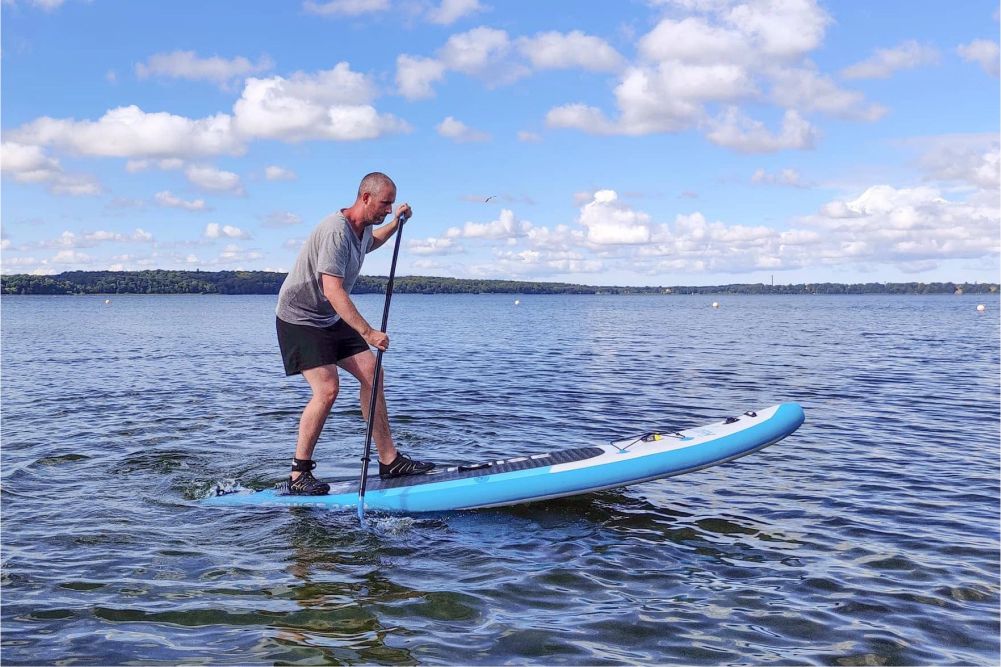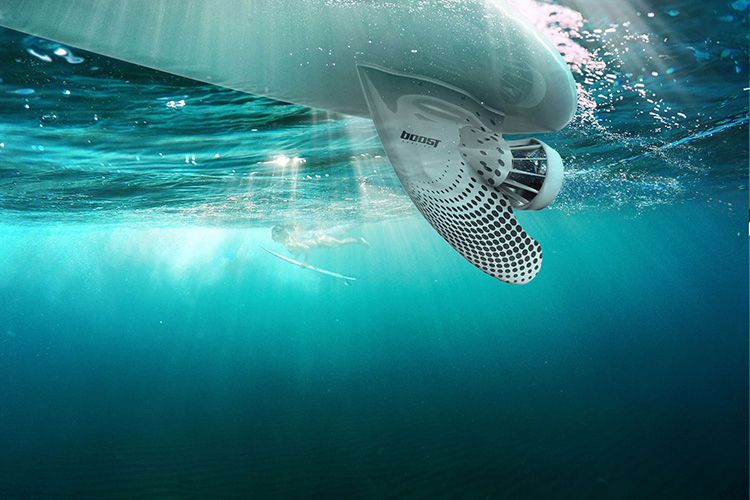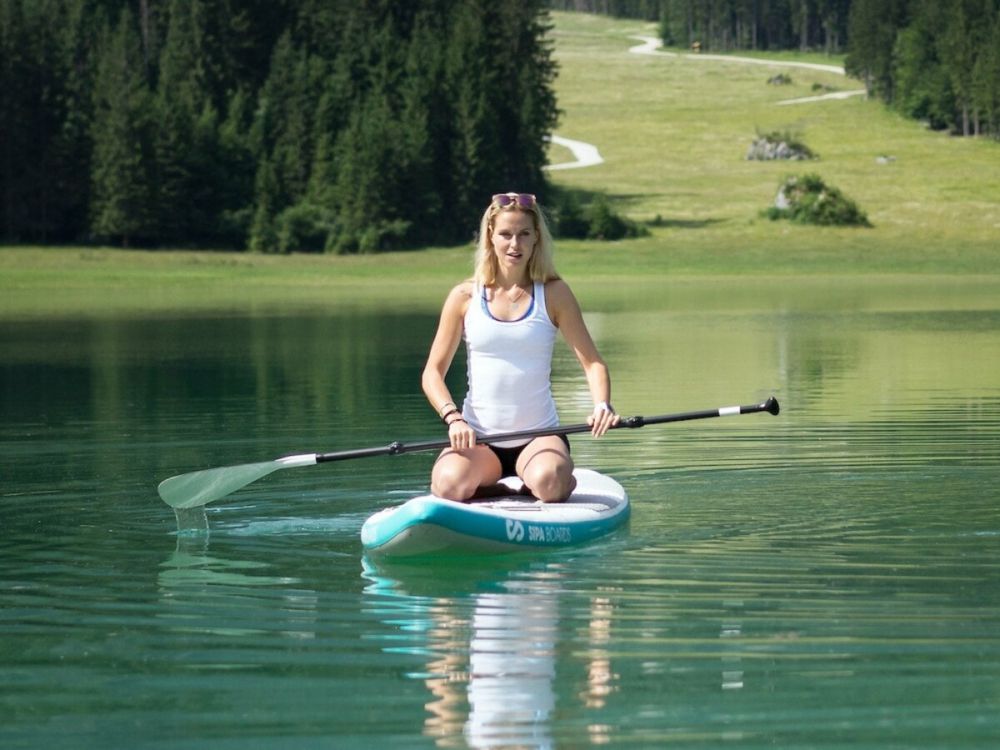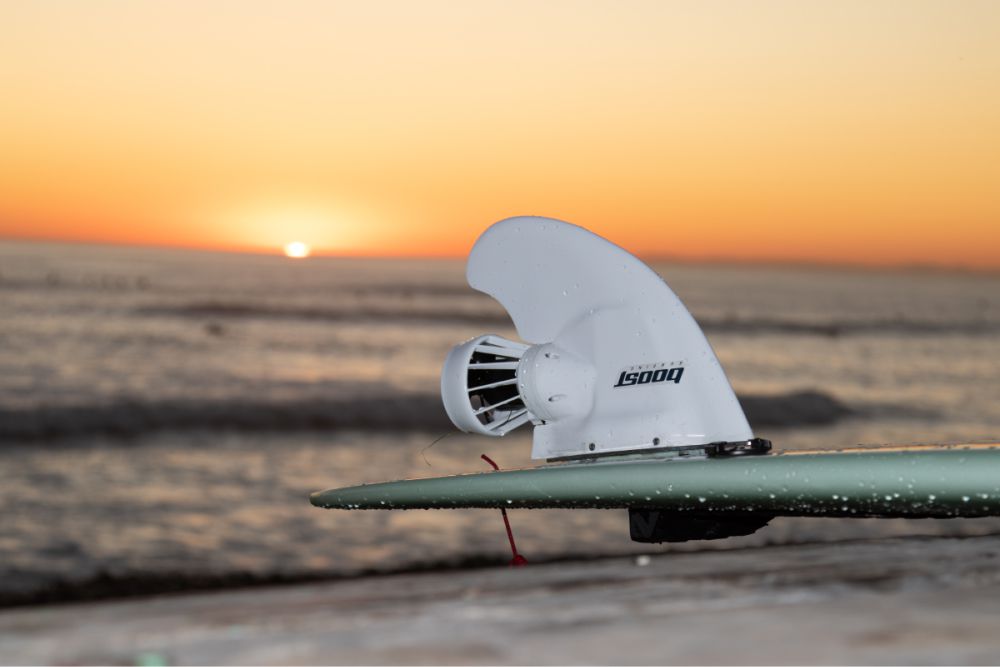Calling out to the adventurers who welcome the future of aquatic exploration, where tech innovation blends in the thrill of water. Say hello to the optimal companion: the electric paddle board. This revolutionary piece of equipment is your ticket to limitless explorations, welcoming both expert paddle boarders or even the first-time curious on the water. It’s time to unfold the details.
What is an Electric Paddle Board?
The electric paddle board, or eSUP as it’s fondly called is a unique watercraft that gives you the freedom to either paddle manually or turn on that electric fin motor for a ride that’s either tranquil or adrenaline-charged.
When it comes to eSUPs, it’s a tale of two types: built-in motors and detachable electric fins. We know it’s intrigued you. Therefore, you’re in for a treat as we delve deeper into this fascinating world.
Electric Paddle Board: E-SUP vs. E-Fin
When you’re weighing the pros and cons of built-in motors vs. detachable electric fins, it can be a bit daunting. Fret not, this comparison aims to shed light on these two options:
E-SUP (Electric Stand-Up Paddle Board)

Pros:
- Integrated System: In an E-SUP, the motor is usually built into the board, providing a seamless experience.
- Better Stability: The board is specifically designed to handle the added weight and power of the motor, making it generally more stable.
- Ease of Use: Generally easier for beginners to use, since the entire system is integrated.
- Optimized Design: The board shape and motor are designed to work in harmony, often resulting in better overall performance.
- Single-Purchase Simplicity: You don’t need to think about compatibility between the board and motor, as it comes as a package deal.
Cons:
- Cost: Typically more expensive than a traditional SUP board or an E-Fin system.
- Weight: Generally heavier due to the integrated motor system, making it a bit cumbersome to carry.
- Less Modularity: You can’t easily upgrade or change out the motor system.
- Limited Options: Fewer design and style choices compared to traditional SUP boards.
E-Fin (Electric Fin System)

Pros:
- Versatility: You can attach the E-Fin system to virtually any stand-up paddle board, transforming it into a motorized paddle board and expanding your options.
- Modularity: Easy to upgrade or change the motor without having to replace the entire board.
- Cost-Effective: Usually cheaper than buying an E-SUP if you already own a compatible SUP board.
- Lighter: The detachable E-Fin system is typically lighter than an integrated motor system, making the board easier to carry when disassembled.
- Customization: Allows for greater customization of your paddling experience.
Cons:
- Compatibility Issues: Not all SUP boards may be compatible with every E-Fin system.
- Assembly Required: Some setup is usually needed to attach the E-Fin to your board, although this is generally straightforward.
- Potential for Mismatch: If not chosen carefully, the E-Fin system could be too powerful or not powerful enough for your SUP board, affecting performance and stability.
- Additional Purchase: If you don’t already own a SUP board, you’ll need to buy one in addition to the E-Fin system, which could make it less cost-effective.
Below is a table to help you easily compare the features, pros, and cons of E-SUP and E-Fin System:
| Feature | Built-in Electric Paddle Board | Electric Paddle Board Fin |
|---|---|---|
| Integration | Custom-designed for the board | Highly versatile; can be added to any SUP |
| Additional Features | May include GPS, auto-inflation, LED lights | Easy attach/detach; quick learning curve |
| Battery Efficiency | 3-5 hours of continuous use | Up to 100 minutes of use with quick charging |
| Versatility | Limited to the specific board | Detachable; can be used on multiple boards |
| Weight | 40-48 lbs (board + motor) | Adds just 2.7 lbs to the existing board weight |
So, if you’re someone who values versatility, lighter weight, and overall simplicity, the electric fin is the winning choice. By understanding these different aspects, you can make an informed decision that best suits your needs for an electrifying water adventure.
The Best Electric Fin for Paddle Board
If you’re already convinced about the merits of an electric fin over a built-in motor for your SUP (Stand Up Paddle Board), the next logical step is finding the best electric fin on the market. And, according to expert reviews, one name stands out: Boost Fin. So why exactly is Boost Fin earning the high praises it’s receiving? Let’s break it down.
Lightweight Design
Boost Fin’s feather-like weight of 2.7 lbs sets it apart from built-in motor paddle boards, which can weigh upwards of 40-50 lbs. This means less drag in the water and easier transport on land—because let’s be real, who wants to lug around a heavy board after an exhausting day of water fun?
Material Compatibility
One of the most enticing aspects of Boost Fin is its versatile material compatibility. Designed from a blend of Glass Fiber Reinforced Polymer and ABS Plastic, it can easily adapt to most paddle boards. That opens up a world of possibilities for SUP enthusiasts, allowing them to retrofit their existing boards with ease.
Power and Speed
Made with a battery that has a remarkable 3500 mAh capacity at 24V and 84 Wh, this Boost Fin can generate up to 800 W of power. Enabling a max thrust of 20 lbs and a top speed of up to 10 mph. Now, that’s something to write about!
Quick Charging
While charging times for built-in electric SUPs often range between 3-4 hours, Boost Fin offers a more convenient experience. Though the specific charging time is not listed, the high-capacity Li-ion battery is generally quicker to charge, giving you more time to enjoy the water.
High Versatility
The Boost Fin is not just another gadget to add to your water-sport arsenal; it’s a game-changing accessory. With its high versatility, it provides a solution for paddlers who wish to switch between a manual and an electrified experience seamlessly.
Top 4 Built-in Electric Paddle Board
If your passion for paddle boarding leans towards a fully integrated experience—where the motor and board are one seamless unit—then these top 4 electric paddle boards are for you.
1. Sipaboards Electric SUP
The Sipaboards Electric SUP is a full-blown aquatic experience for avid paddle boarders. With a top speed of 8 mph and a battery duration of 3 hours, this board offers a perfect blend of longevity and performance. Noteworthy special features like GPS and auto-inflation make it an all-rounder. It’s built with a 45-pound frame that ensures stability without compromising agility.

-
Pros:
- GPS integration for advanced tracking
- Auto-inflation feature for convenience
- Solid battery life
-
Cons:
- Limited versatility due to the built-in motor
- 3-hour charging time
2. JOBE E-Duna
Meet the JOBE E-Duna, a masterpiece designed for your comfort and enjoyment. With its top speed of 7 mph and a battery life expanded of 2.5 hours. Not to mention the LED lights and an anti-slip deck, the board shines in both functionality and modern design. It weighs in at 40 pounds, making it lighter compared to the other electric jet paddle boards in its class.
-
Pros:
- LED lights for enhanced visibility
- Anti-slip deck for safety
- Lighter weight
-
Cons:
- Limited versatility due to built-in motor
- Shorter battery duration
3. Torque e-Paddle
The Torque e-Paddle shines when it comes to integrated storage and GPS capabilities. With a higher top speed of 10 mph and a 4-hour battery life, it offers both performance and endurance. The board weighs 42 pounds, striking a balance between stability and maneuverability.

-
Pros:
- Built-in storage for convenience
- Longer battery duration
- GPS integration
-
Cons:
- Limited versatility due to built-in motor
- 2.5-hour charging time
4. Rover Motorized Paddle Board
Last but not least, the Rover Motorized Paddle Board brings power and performance to the forefront. Boasting a top speed of 12 mph and an impressive 5-hour battery life, it sets a new standard in the electric paddle board market. The board has a high weight capacity and self-inflating features, making it an excellent choice for heavier riders or those carrying additional equipment.
-
Pros:
- High top speed
- Impressive battery duration
- High weight capacity
-
Cons:
- Limited versatility due to built-in motor
- 4-hour charging time
How Fast Is The Electric Paddle Board?
An electric paddle board can reach speeds of around 3 to 5 miles per hour (5 to 8 kilometers per hour). Some high-performance models might go faster, potentially up to 10 miles per hour (16 kilometers per hour) or more.
To help you streamline your decision-making process, we’ve created a data-driven comparison table between electric motor SUPs.
| Feature | Sipaboards Electric SUP | JOBE E-Duna | Torque e-Paddle | Rover Motorized Paddle Board |
|---|---|---|---|---|
| Top Speed (mph) | 8 mph | 7 mph | 10 mph | 12 mph |
| Battery Duration (hours) | 3 hrs | 2.5 hrs | 4 hrs | 5 hrs |
| Charging Time (hours) | 3 hrs | 3 hrs | 2.5 hrs | 4 hrs |
| Weight of Board/Motor (lbs) | 45 lbs | 40 lbs | 42 lbs | 48 lbs |
| Special Features | GPS, Auto-inflation | LED lights, Anti-slip deck | Built-in storage, GPS | Self-inflating, High weight capacity |
With these features coming to light, it would set an easier path for the avid paddle boarders to make the wise choice.
How Much is An Electric Paddle Board?
Electrifying your paddle boarding experience is now a reality thanks to electric SUPs and fins. But let’s face it, going electric doesn’t come cheap.

The Average Cost of Electric SUP
Regarding electric stand up paddle boards, the price range fluctuates depending on the brand, performance, and added features, but you’re looking at a ballpark number of $2,000 to $6,000. Unfolding the actual price, the Sipa Smart Motorized Paddle Board ranges at $3,790, while JOBE E-Duna is at $2,499, and the Torque e-Paddle comes in at $2,500. The higher cost reflects advantages like greater speed, extended battery life, and additional premium features, making it a worthwhile investment for many.
The Average Price of SUP with an Electric Fin
If you already own a paddle board and are interested in making it electric, there’s a less expensive route: the electric fin.
These devices attach to your existing paddle board and give you that electric kick you’re looking for without the need for a brand-new board. The average cost of these attachable motors lies between $200 to $1,000. For instance, the Boost Surfing Electric Fin for paddle boards comes at a price point of $499, offering a top speed of 10 mph and a battery duration of nearly 2 hours.
Boost Your Paddle Boarding Experience: Electric SUPs vs. Electric Fins
As paddle boarding enters the electric age, the options for adding some extra ‘zip’ to your aquatic adventures have broadened—but so have the costs. From high-end electric paddle boards to more budget-friendly electric fins like Boost Surfing, there’s an amazing thing for every water enthusiast. The decision ultimately boils down to your existing setup, your paddling needs, and of course, your budget. Armed with this comprehensive financial guide, you are now better positioned to make an investment that will not only enhance your paddle boarding experience but also offer value for your money. Choose wisely and paddle on.



Share:
Electric Water Boards: The Ultimate Guide
Best 5 Motorized Paddle Boards and Alternatives [2024 Update]